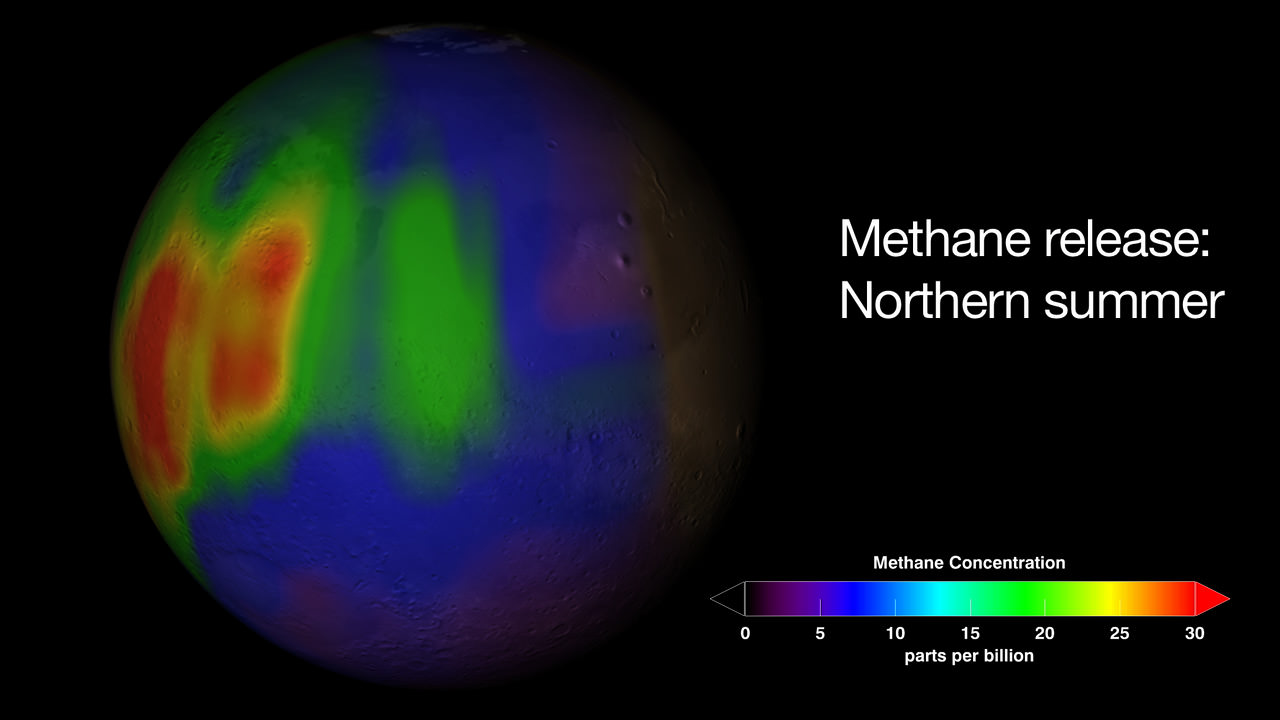[/caption] Methane has been measured in large quantities in Mars atmosphere over several seasons, meaning Mars is active, either geologically or biologically. "We found methane," said Dr. Geronimo Villanueva from the NASA Goddard Space Flight Center, one member of a team of scientists reporting on their research at a press conference today at NASA Headquarters. "We can measure not only the methane, but where it is coming from and when it is being released." This is the first definitive detection of methane on Mars that includes maps identifying areas of active release. "Mars is active," said Michael Meyers, lead NASA scientist for the Mars Program, "but we don't know if it's because of biology or geology or both."
The methane on Mars was first detected in 1999, again in 2001 and 2003, which was widely reported, but not much was known about the origin or amount of the gas on Mars.
The research team found methane in the atmosphere of Mars by carefully observing the planet over several Mars years, and during all the Martian seasons with NASA's Infrared Telescope Facility, run by the University of Hawaii, and the W. M. Keck telescope, both at Mauna Kea, Hawaii.
Measurements were made using spectroscopy by which light is split into its individual wavelengths, and then the "fingerprint" of individual molecules can be identified.
From Earth the aperture of the spectrometer is placed along the north-south direction of the planet, and during observations, the instrument can acquire between 30 and 50 individual spectra of Mars for every sixty seconds. Doing this they can build a map of the planet, as the planet rotates under the "slit" or aperture of the spectrometer. [caption id="attachment_23676" align="aligncenter" width="580" caption="In this illustration, subsurface water, carbon dioxide and the planet's internal heat combine to release methane. Although we don't have evidence on Mars of active volcanoes today, ancient methane trapped in ice "cages" might now be released. Credit: NASA/Susan Twardy "]
[/caption] The origin of methane could either be geologic where water reacts with hot rock and produces methane gas which escapes through pores in the planet's surface in a process called serpentinization. Or it could be evidence of biology under the surface, where the methane generated by microbes could accumulate and then escape through the rocks.
Three regions of active release of methane were found and were seen over areas that show evidence of ancient ground ice or flowing water. The plumes of methane appeared over northern hemisphere regions such as east of Arabia Terra, the Nili Fossae region, and the south-east quadrant of Syrtis Major, an ancient volcano 1,200 kilometers (about 745 miles) across.
"We observed and mapped multiple plumes of methane on Mars, one of which released about 19,000 metric tons of methane," said Villanueva. "The plumes were emitted during the warmer seasons -- spring and summer -- perhaps because the permafrost blocking cracks and fissures vaporized, allowing methane to seep into the Martian air. Curiously, some plumes had water vapor while others did not," said Villanueva. The rate of release is about 1 pound per second or .6 kg per second.
"Methane is quickly destroyed in the Martian atmosphere in a variety of ways, so our discovery of substantial plumes of methane in the northern hemisphere of Mars in 2003 indicates some ongoing process is releasing the gas," said Dr. Michael Mumma of NASA's Goddard Space Flight Center in Greenbelt, Md. "At northern mid-summer, methane is released at a rate comparable to that of the massive hydrocarbon seep at Coal Oil Point in Santa Barbara, Calif."
Another team member, Lisa Pratt, professor of geological sciences, Indiana University in Bloomington, elaborated on whether the process creating the methane could be geological or biological. "If there is an "A" line of evidence that makes me think we need to seriously consider biology, it's the processes in the subsurface that would allow for methane generation that seems slightly more plausible for biology than geochemistry," she said. "Serpentinization is a simple water/rock reaction and is a process we see only in a few special places on Earth, usually associated with major fracturing and faulting that allows mantle like materials to be exposed to sea water and groundwater. That's a process that 'plugs up the plumbing' and isolates the reactive site, and we don't see a lot of evidence for major active, deep faulting and uplift that would bring these reactive materials into contact with water."
While the team reported on results from observations in 2003 and 2006, they said they were not at liberty to discuss findings from subsequent observations, as the work to decipher the findings is still being done. But they hinted that relatively soon, more information would be available. They are also developing a strategy for further studies with ground-based telescopes, current spacecraft orbiting Mars, and future spacecraft such as the Mar Science Laboratory, as well as re-looking at data already obtained to see if more clues can be found as to the origin of the methane on Mars.
Sources: NASA press conference,
NASA
 Universe Today
Universe Today
